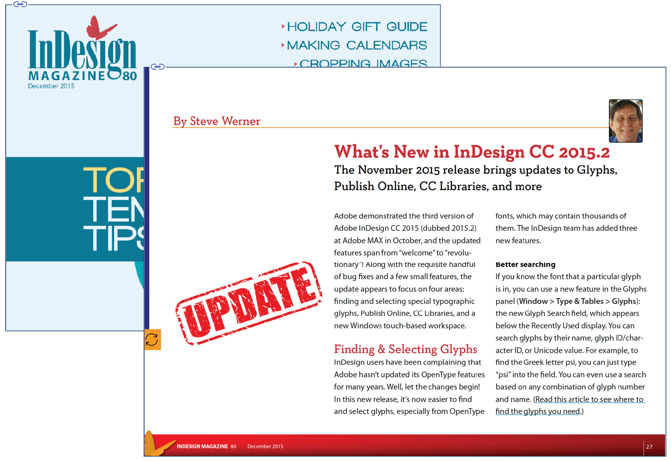What’s New With InDesign CC 2015.2

Adobe has released updates to several important Creative Cloud applications, including InDesign CC 2015.

In their 2015.2 versions, all of the main apps have jettisoned their old Welcome screens in favor of a new Start screen. This new screen makes it easier locate recent files, create new files, manage CC libraries and presets, and access Adobe stock photos and tutorials. Here’s what the Start screen looks like in InDesign:

New InDesign features include several enhancements to CC Libraries, including the following:
- Add all members of a group to a library with one click (including color groups and style groups)
- Add color themes and/or individual swatches to the Swatches panel without having to apply those colors to page objects
- Add multiple styles, swatches, or graphics to a library with one click
- CC libraries can now be searched, finally!
We also have a revamped Color Theme panel:

It’s a little easier to make accessible PDFs, thanks to the new ability to designate a title for the PDF and to display that title in the PDF via a setting in the PDF Export dialog box.

Smaller changes include:
- An increase in the number of recent documents you can display (up to 20)
- New page sizes for Web and Digital Publishing

- The ability to make the Eyedropper take priority over the Color Theme tool (yay!)
A comprehensive review of the new features
In addition to the features above, the new release includes the features announced at Adobe MAX, which Steve Werner covered here a few weeks ago. These include enhancements to the Publish Online service, new features for finding and selecting glyphs, and a special workspace where users of Microsoft Windows touch-enabled devices can quickly sketch out new layouts with gestures, similar to the Adobe Comp CC app.
For a full, deep dive into every new feature of InDesign CC 2015.2, see issue 80 of InDesign Magazine.

Also, be sure to check out the latest version of James Wamser’s Guide to InDesign New Features, which includes the features in this latest release. You can view the guide via Publish Online or download a PDF.
Bug Fixes in InDesign CC 2015.2
The new release of InDesign also sports several welcome bug fixes, addressing problems with crashing, cross-references, data merge, relinking, EPUB, and more.
Macintosh: El Capitan issues
- InDesign no longer crashes on launch when “Automatically hide and show the menu bar” option is enabled.
- Navigation window’s Title Bar is no longer missing in Open/Place dialogs.
- Relink functionality now works properly.
Publish Online
- No more white bounding box when multiplying transparency effects on JPG graphics.
- Ease In/Ease Out animation setting now behaves correctly.
- State actions are now honored in Publish Online export when buttons are anchored in a multi-state object (MSO).
Fonts, Text, Styles, Data Merge
- Previewing a font in dialog box adds font to Recent Font list.
- Users can now use Verdana OTF font from Document Fonts folder
- Fit Frame to Content now works when the last character of the line is hyphen, em-dash, or en-dash.
- Paragraph shading appearance consistently updates when removing forced line breaks from paragraph.
- Now able to use Character Styles inside Cross-Reference formats.
- Data Merge with multiple records no longer ignores changes in page dimensions when applied merge on master page.
EPUB
- State actions are now honored in FXL EPUB export when buttons are anchored in a multi-state object (MSO).
- Exporting to EPUB 3 Fixed Layout now embeds and displays the fonts in the EPUB if they are present in the package, and font embedding now works when World-Ready composer is selected.
XML
- InDesign CC no longer crashes when deleting XML elements that contain missing tables.
- XML import now works when pointing to transformation file in CC versions.
Direct Download Links
If you’re one of the folks who has had trouble installing updates with the CC application, check out the following posts at ProDesignTools.com, where they have a table of links to direct downloads of all the application updates (not just InDesign), and instructions for both Mac and Windows.
This article was last modified on July 25, 2019
This article was first published on December 1, 2015




